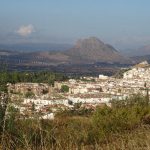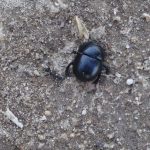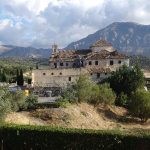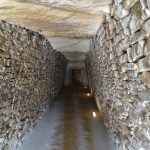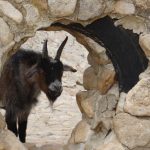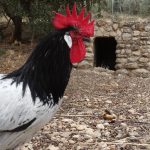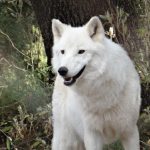Dung Beetles, Dolmens and Lobos
There’s a lovely hiking trail in the hills overlooking Antequera – almost four kilometers of relatively flat, rock-strewn sandy path. It meanders its way past the remains of 17 Roman Arquillas – a system which carried water into town, while providing stunning views over the town and Peña de los Enamorados one way … tree-covered hills, farms and a
golf course (!) the other. The brilliant green of the fairways look totally out of place in an otherwise arid-looking landscape, but at least they have built two large reservoirs/rain catchment areas for watering the grass. The morning’s cloudburst must have done wonders in replenishing them. There were still a couple of puddles along the trail, but the sandy soil had sucked up the moisture almost immediately. Curious patches of black, polka-dot holes edged the path every few steps … a closer look revealed busy colonies of ants, industriously clearing out their underground tunnels after the deluge. No anthills visible … just a scattering of small, black holes like openings in a pepperpot. Careful where you stand when taking photos – the much larger guard ants had particularly large pincers … and held them aloft, menacingly!
Further along, a glossy black beetle – totally impervious to the ant currently investigating its leg – trundled along like an armoured tank. Is that …? Yes … it IS a dung beetle! We used to see lots of them in the dunes along the coast, rolling balls of dung three or four times their size … the spheres looking for all the world like sugar=coated chocolate truffles! Occasionally, they’d lose control of their prize, and have to cling on tightly as they both rolled to the bottom of the dip … necessitating another uphill climb. Well, there was plenty of ‘dung’ at the beginning of the trail — it seems people bring their BIG dogs up here for walks! Great video: https://youtu.be/I1RHmSm36aE
At the end of the trail is a former convent – now turned posh hotel and restaurant – Hotel Magdalena. And what a glorious locale. Gardens filled with banks of flowering rosemary – smelling wonderfully resinous when brushed against. Mauve and Magenta bougainvillea draped – oh so casually – over rock walls, bushes of pink and white Oleander lined the driveway, olive trees laden with ripening bright green olives and the distant valleys and smoke-gray mountains provided the perfect backdrop.
A twenty minute walk from where we’re staying, and just on the edge of town, are two of the Dolmens. Ancient underground monuments – the earliest dating back 5000-6000 years and consisting of gigantic slabs making up the walls and roof. The cut edges are remarkably precise and It’s hard to imagine how those massive roof slabs could be moved into place. It was only after visiting the Antequera museum that we found out the secret … they lay the roof pieces on the ground first and then excavated the cavern underneath … reinforcing with vertical pillars as
they went. Very clever. https://www.andalucia.org/en/antequera-cultural-tourism-dolmen-de-menga These two dolmens are aligned in some way with the mountain La Peña Enamorada – especially during the summer and winter solstices . . . there is a large sundial for just this purpose.
At the interpretation centre, a photo panorama took up an entire wall, however two middle-aged couples hogged the whole display. Pictures were taken of one wife … facing this way … then the other … with arms outstretched … standing in the centre. Repeated with the other wife . . . then one couple together . . . and t’other. ARGHHHH . . . how many photos of this were they actually going to look at when they got home!! People walked out in disgust, but it didn’t make any impression with these four. We left them to it and enjoyed the monuments.
The Roman era Dolman is considerably younger – a mere 2,000 years old, and set some distance away from the others. The construction is vastly different though – small clay bricks create the entrance tunnel and circular, domed roof. Significantly easier to construct, I would imagine.
Los Lobos Park sits at the foot of El Torcal. https://www.lobopark.com/ Only open from Thursday to
Sunday, the tours have to be booked ahead and each is just over an hour long. The co-owner, Daniel, worked for many years studying dogs and training them for police and military services, but about 20 years ago he became interested in creating a specialized park where Tundra, Timber and the endangered Iberian wolves could establish packs and live out their lives in as normal a setting as possible. Iberian wolves have been hunted to extinction here in Andalucia and only exist in the wild in northern Spain. The park has accepted wolves from zoos all over the EU . . . in fact a new female Tundra wolf had just arrived . . . and two more were in transit from the Ukraine – stuck in Madrid due to red tape bureaucracy. Once wolves reach adolescence at about two and a half, if they are not already in a pack, they cannot be introduced, or re-introduced to one … a new pack would have to be established. . . sometimes just females or in one case ‘the bachelor brothers’.
The park also takes in other abandoned or homeless critters like pot-bellied pigs, goats and chickens.
The current 28 wolves are comfortable with humans around their (huge) enclosures, but are in no way tamed. The original pups were hand reared by Daniel, but once they were adults and had formed a pack he stepped back and left them to do what wolves do in the wild. One of the guests asked if they ever howled … and Daniel obliged by walking over to the bachelor enclosure, and howled … the five wolves inside rushed up and howled along … pretty soon there were responses from all over the acreage. Enough to give you goosebumps.
